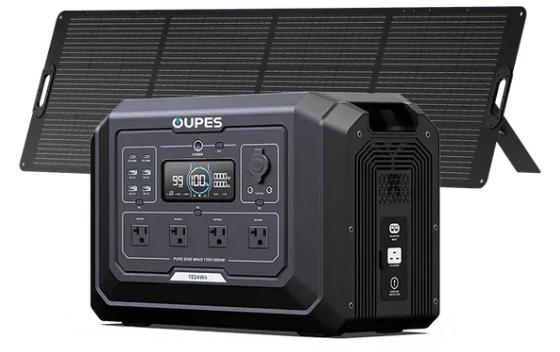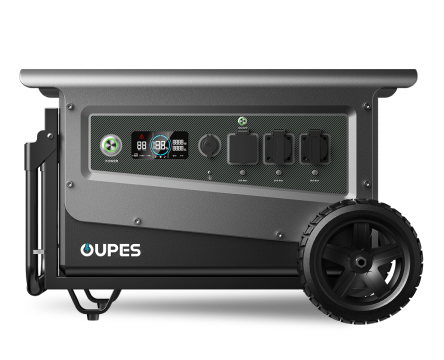
Table of Contents
- Introduction
- How Snowfall Affects Solar Efficiency
- The Science Behind Solar Energy in Snowy Conditions
- Comparison: Performance in Snow vs. Clear Conditions
- How to Improve Efficiency During Snowfall
- Solar Generators and Winter Power Supply
- Safety and Maintenance Tips for Winter Operation
- FAQ
Introduction
Solar energy is one of the most sustainable and cost-effective ways to generate power. However, when winter arrives, snowfall can raise concerns about how efficiently solar panels and portable power stations can operate. While many assume that snow drastically reduces performance, the truth is more nuanced. In some cases, cold weather can actually help solar panels work better — as long as snow coverage is managed correctly.
According to the U.S. Department of Energy (DOE), solar panels can still generate energy during snowy conditions, but efficiency depends on snow accumulation, panel angle, and sunlight availability. This article explores the technical effects of snow on solar generation, practical solutions, and what it means for both rooftop systems and portable solar generators.
How Snowfall Affects Solar Efficiency
1. Snow Coverage Blocks Sunlight
The most direct impact of snowfall is that it blocks sunlight from reaching solar cells. When panels are covered with even a thin layer of snow, the ability to convert sunlight into electricity drops significantly. Thick or wet snow can block almost 100% of light, temporarily halting production.
2. Reflection Can Increase Output
Paradoxically, snow can also help solar systems. Snow-covered ground reflects sunlight — a phenomenon called the albedo effect. This reflection can slightly increase energy production when panels are clear but surrounded by snow. Studies by the National Renewable Energy Laboratory (NREL) have shown that this reflected light can raise solar output by 5–15% under optimal conditions.
3. Temperature Improves Electrical Efficiency
Cold temperatures can improve the electrical performance of photovoltaic (PV) cells. Unlike many electronic devices, solar panels operate more efficiently in cooler climates. For every 1°C drop below 25°C (77°F), energy output may increase by about 0.4–0.5%.
The Science Behind Solar Energy in Snowy Conditions
Solar panels work by absorbing photons from sunlight and converting them into electricity through semiconductor materials. When snow accumulates, it creates a barrier that prevents light absorption. However, snow’s reflective nature can also redirect light to panels at different angles, depending on installation design.
Key Factors Affecting Performance
- Panel Tilt Angle: Steeper panels shed snow faster and reduce buildup.
- Ambient Temperature: Cold weather lowers resistance, improving panel efficiency.
- Snow Type: Wet, heavy snow sticks to panels longer than dry, powdery snow.
- Sunlight Duration: Shorter daylight hours in winter naturally reduce total energy production.
Case Study: Winter Solar Performance in Northern States
According to research by NREL, average solar production in northern U.S. regions like Minnesota or Maine can drop by 10–30% during heavy snow months. However, systems with optimized tilt angles and active snow management recover efficiency quickly after storms.
Comparison: Performance in Snow vs. Clear Conditions
| Condition | Average Energy Output | Temperature Effect | Recommended Maintenance |
|---|---|---|---|
| Clear, Sunny Weather | 100% (optimal output) | Normal efficiency | Regular cleaning and inspection |
| Light Snow with Reflection | 80–90% | Improved efficiency due to cool temperature | Remove thin snow manually or wait for sunlight to melt it |
| Heavy Snow Coverage | 0–30% | Little to no generation | Clear panels using a soft brush or heated method |
| Post-Snow Melt (High Albedo) | 90–105% | Enhanced performance from reflected light | Keep surroundings free of debris |
How to Improve Efficiency During Snowfall
1. Adjust the Panel Angle
If possible, increase your panel’s tilt to 30–45 degrees. Steeper angles help snow slide off naturally and maximize sun exposure. Portable solar panels used with solar generators are often adjustable, allowing users to optimize positioning throughout the season.
2. Use Snow-Resistant Coatings
Some panels are treated with hydrophobic coatings that minimize snow adhesion. These coatings reduce maintenance needs and improve self-cleaning capability during light snowfalls.
3. Manual or Heated Removal
For heavy snow, gently brush panels using a soft, non-abrasive tool. Avoid metal scrapers that could damage the glass surface. In critical systems, heating cables or automated snow-melt technologies can also be installed.
4. Keep Surrounding Areas Clear
Clearing snow from the ground around solar setups helps maximize the albedo effect and reflected light absorption. This small step can add measurable efficiency gains in winter.
Solar Generators and Winter Power Supply
1. Why Portable Systems Perform Better in Snow
Unlike fixed rooftop installations, portable solar generators can be repositioned to capture maximum sunlight. Users can move them to areas with less snow accumulation or adjust angles based on sun direction.
2. Cold Weather Battery Performance
Lithium batteries, like those used in OUPES portable power stations, typically perform best between 0°C and 40°C. In freezing conditions, capacity can drop by 20–30%. To counter this, some high-quality systems include internal heating elements or thermal management features that maintain optimal temperature for charging and discharge.
3. Off-Grid Reliability
During winter storms, grid outages become more common. Having a portable solar generator ensures continuous backup power for essential devices like heaters, lights, and communication tools, even in snowy weather.
Safety and Maintenance Tips for Winter Operation
1. Avoid Ice Accumulation
Ice can be more damaging than snow, adding weight and potential stress on panel mounts. Check structures after storms to ensure stability and remove ice carefully.
2. Monitor Output Regularly
Use system monitoring tools or built-in display screens on solar generators to track voltage and charging performance during the winter season.
3. Store Equipment Properly
For portable systems, store solar panels and batteries indoors when not in use. Extreme cold can affect both lithium cells and inverter components if left outside for extended periods.
4. Schedule Professional Inspections
For fixed installations, annual winter maintenance by certified technicians can help detect wiring issues, insulation wear, or frame corrosion caused by snow exposure.
FAQ
1. Do solar panels work when covered in snow?
If fully covered, solar panels cannot generate power. However, partial coverage or light snow may still allow some light to pass through.
2. How much does snow reduce solar output?
On average, snow can reduce output by 10–40% depending on depth, duration, and temperature. Once cleared, systems return to full efficiency.
3. Should I clear snow off my solar panels?
Yes, if it’s safe to do so. Use soft brushes and avoid applying heat directly to the surface.
4. Can cold weather damage my solar generator?
Cold temperatures can reduce battery capacity temporarily but won’t permanently damage the system if used properly. Models like those from OUPES feature temperature protection for safe operation.
5. How can I keep portable solar panels efficient in snow?
Adjust the angle, clear snow regularly, and position panels toward direct sunlight whenever possible.
6. Do solar panels need direct sunlight in winter?
Not necessarily — panels can still generate power under cloudy or diffuse light conditions, though at lower output levels.




























